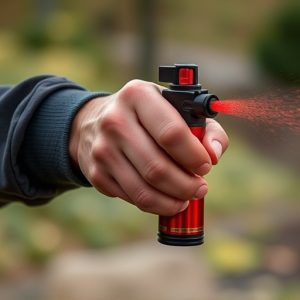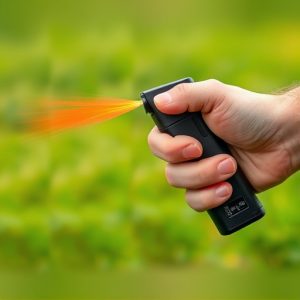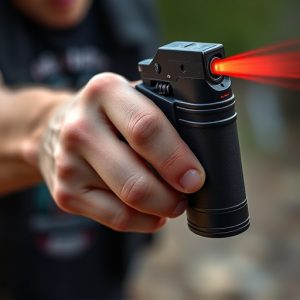Safe Use of Pepper Spray for Civilians: A Comprehensive Guide
"When to Use Pepper Spray Safely guides users through the safe handling, application, and selec…….
"When to Use Pepper Spray Safely guides users through the safe handling, application, and selection of this non-lethal self-defense tool. It emphasizes understanding local legal frameworks, proper training from licensed retailers or law enforcement, and safe usage techniques. Key practices include inspecting canisters for damage, storing them securely, applying at arm's length towards eyes, nose, and mouth, ensuring good ventilation, and washing afterward. Users should consider their specific needs—like spray range, weather resistance—and always use it as a last resort while adhering to local laws."
“In today’s diverse and sometimes unpredictable world, civilian protection has become a pressing concern. One effective tool gaining popularity is inflammatory spray, offering a non-lethal means of self-defense. This comprehensive guide explores the intricacies of pepper spray, its legal considerations, and safe handling practices for optimal protection. From understanding key ingredients to selecting the right spray for your needs, we empower civilians with knowledge on when and how to use pepper spray safely.”
- Understanding Pepper Spray: Active Ingredients and Their Effects
- When is Pepper Spray Legal for Civilian Use?
- Safe Handling and Application Techniques for Optimal Protection
- Choosing the Right Pepper Spray for Your Needs
Understanding Pepper Spray: Active Ingredients and Their Effects
Pepper spray, also known as oleoresin capsicum (OC) spray, is a non-lethal self-defense tool designed to incapacitate an assailant temporarily. Understanding its active ingredients and effects is crucial when considering its safe use for civilian protection. The primary active ingredient is capsaicin, the compound that gives chili peppers their heat. When sprayed, capsaicin irritates the eyes, nose, throat, and skin, leading to a burning sensation and temporary blindness. This disruption causes the assailant to become disoriented and temporarily unable to fight back.
The spray typically contains a high concentration of capsaicin oil mixed with a carrier solution, often containing water and other additives. The concentration of capsaicin varies among brands, usually ranging from 1% to 2%. When used correctly, pepper spray can provide individuals with a valuable defense mechanism in various situations, such as during attacks or when encountering dangerous individuals. Always follow safety guidelines for usage, including proper handwashing after use and avoiding eye contact to prevent prolonged irritation.
When is Pepper Spray Legal for Civilian Use?
Pepper spray, also known as oleoresin capsicum (OC) spray, is a popular self-defense tool for civilians. However, its use is subject to legal restrictions that vary by jurisdiction. To use pepper spray legally and safely for civilian protection, individuals must understand when it’s permitted. In many regions, pepper spray is legal for civilians if they are in a situation where they feel their personal safety is at risk and there’s an imminent threat of physical harm. It’s commonly accepted as a legitimate means of self-defense against attackers, especially in public spaces like streets or parks.
The legality extends to situations where one might be confronted while en route to or from work, during leisure activities, or even inside homes, provided the use aligns with local laws. Individuals must also ensure they possess the spray legally, either through purchase from licensed retailers or as supplied by law enforcement agencies for specific purposes. Proper training on its safe and effective usage is crucial to minimize risks of accidental injuries and ensure the spray’s effectiveness in deterring potential threats.
Safe Handling and Application Techniques for Optimal Protection
When using inflammatory spray, or pepper spray, for civilian protection, safe handling and application techniques are paramount for optimal results. Always inspect the canister before use to ensure it’s not damaged and that the seal is intact. Store the spray in a secure, controlled environment out of reach of children and unauthorized personnel. Pepper spray should only be deployed when faced with an imminent threat or as a last resort to escape a dangerous situation.
For safe application, hold the canister at arm’s length and aim towards the assailant’s eyes, nose, and mouth. Squeeze the trigger firmly but briefly, releasing just enough spray to create a burning sensation and disorient the attacker. Ensure you’re in a well-ventilated area as pepper spray can be harmful if inhaled by both the target and bystanders. After use, wash your face and hands thoroughly with soap and water, and store the canister safely until needed again.
Choosing the Right Pepper Spray for Your Needs
When considering a pepper spray for civilian protection, understanding your specific needs is crucial. Different scenarios require varying levels of force and reach, so selecting the right spray is essential. Look for factors like spray range, effectiveness against different assailants, weather resistance, and ease of use. For instance, if you’re concerned about close-quarters attacks in low-light conditions, a spray with a shorter range but powerful punch and glow-in-the-dark features might be more suitable than a long-range option.
Knowing when to use pepper spray safely is equally important. Pepper spray should always be used as a last resort for self-defense. It’s illegal in many places without proper training or a permit, so ensure you understand local regulations. Safe usage involves aiming for the face and eyes, practicing with a dummy or target, and being familiar with the spray’s activation mechanism to avoid accidental deployment. Regular maintenance and expiration date checks are also vital to guarantee its effectiveness when needed.
Pepper spray can be a powerful tool for civilian protection when used safely and responsibly. By understanding its active ingredients, legal considerations, and proper handling techniques, individuals can make informed decisions about their personal safety. Choosing the right pepper spray for your specific needs ensures effectiveness in unexpected situations. Remember, knowing when to use pepper spray safely is key to protecting yourself while adhering to legal guidelines.


